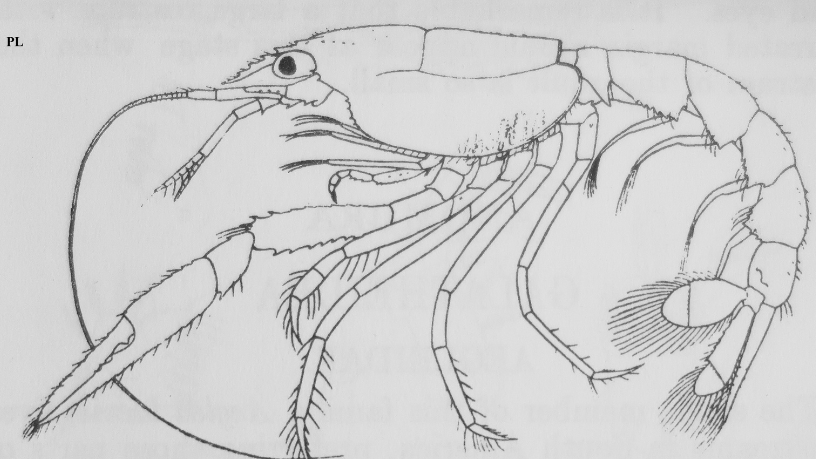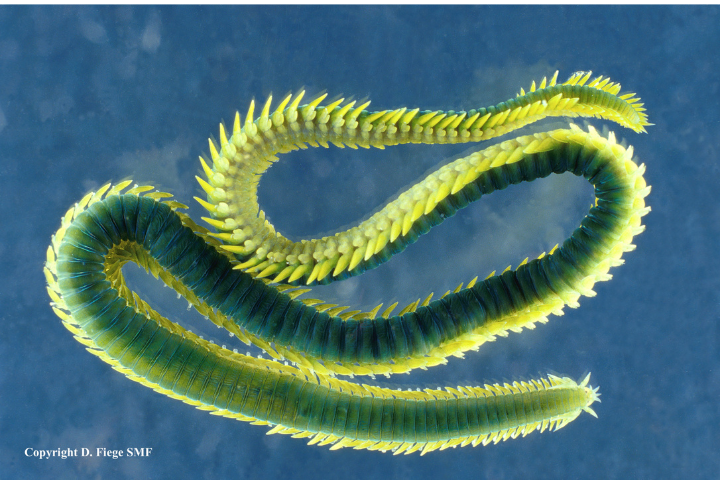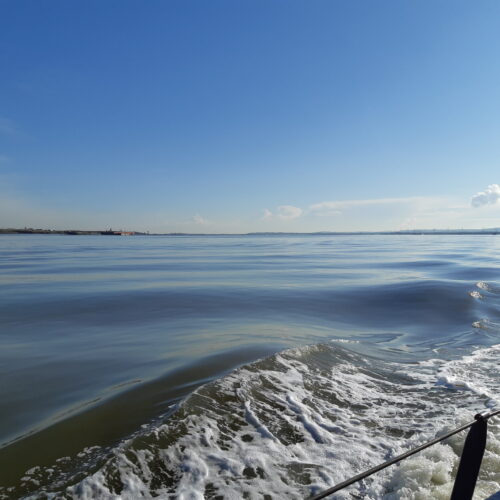The mud shrimp Jaxea nocturna and its extraordinary “Trachelifer” larva
Jaxea nocturna, a member of the mud shrimp family Laomediidae, occurs widely across the Northeast Atlantic and Mediterranean Sea. Adult mud shrimps construct and live in elaborate burrows in mud or sandy mud. The burrowing activity of these shrimps contributes significantly to bioturbation processes in the sediment. Burrows of Jaxea nocturna are reported from depths between 15 to 420 m in waters around the UK.
Among the different mud shrimp species, Jaxea nocturna is remarkable for its extraordinary larva, also called “Trachelifer”, which is characterised by an extremely long “neck” area between the eyes and the mouth (Figure 1). These larvae are frequently recorded in plankton hauls between March and December. (1, 2).
When first described by Brook in 1889 (3) from a plankton haul off the West coast of Scotland, the development of many crustaceans was not yet fully understood and this typical larva was named “Trachelifer” (based on the greek root “trachel” for neck and “fer” for carrying). Since then our understanding of crustacean development has advanced considerably. Due to the works of Marie Lebour (in the early 20th century), followed notably by Robert Gurney and D.I. Williamson, to name a few, most decapod larvae can now be related to their respective adults. (2, 4)

(Note: drawings not to scale, total length Z I = 4.5mm, Z V = 12 mm)
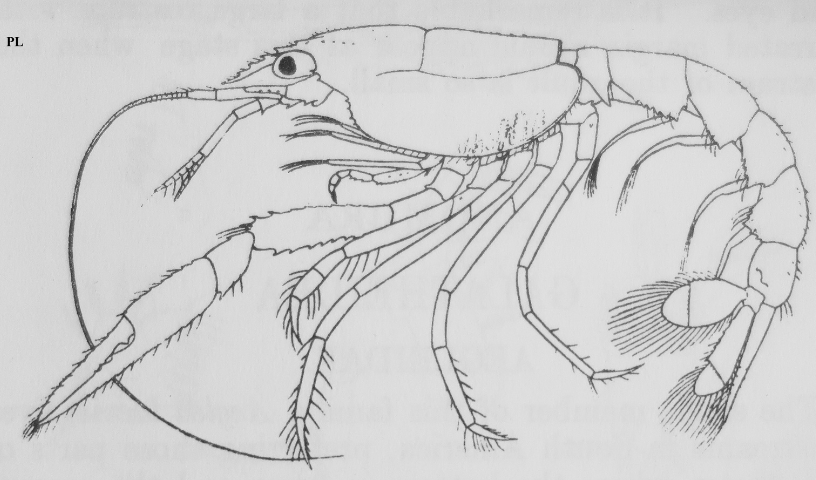
(Note: large eyes and long rostrum compared to the adult and reduced size compared to the older larva Z V)
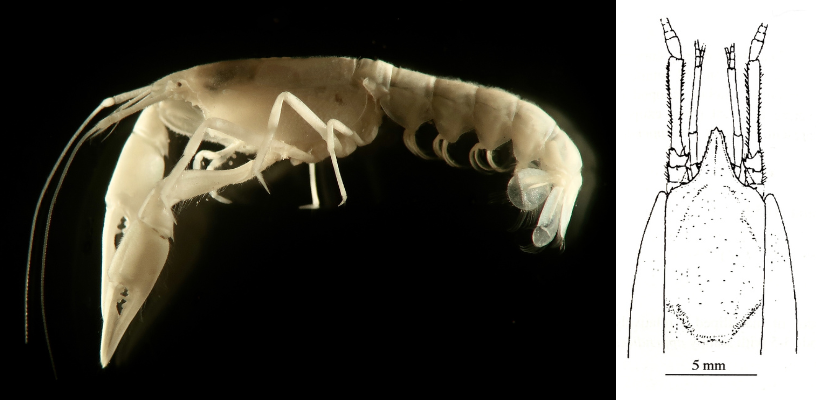
The life cycle of Jaxea nocturna is similar to the one displayed by many other decapod crustaceans. The development consists of a series of stages separated by moults. During a moult, the carapace softens and is shed off, allowing the animal to grow in size. During this time the animal is rather vulnerable and not able to move much. The carapace then hardens again for protection and also to provide the necessary stability for swimming or walking around. After hatching from the egg and a brief early stage called “pre-zoea”, the larval stages (= “zoea” stages) are free-swimming and found in the plankton, which is the community of organisms floating in the water column and subject to currents and tides.
The larva or zoea differs usually significantly in form from the adult. The larval phase of Jaxea nocturna consists of six zoea stages (Z I to Z VI), and the form is staying essentially the same (Figure 1). In the succession of larval stages, the animals grow in size and develop their various appendages, such as legs and tail. The moult from the last larval stage to the next, the first postlarval stage (also called “decapodit” or “megalopa”) is radical and consitutes a typical metamorphosis (Figure 2).
In its form the postlarva is similar to the adult, with some larval characters retained, such as large eyes and long rostrum. After the next moult the young adult (or juvenile) resembles the adult (Figure 3), but for its smaller size and the fact that it is usually not mature, which means capable of reproducing. (4, 5, 6, 7)
Returning to our larvae and adults of Jaxea nocturna figured above, except for the radical change in form between the larval and postlarval phases, the considerable reduction in size is noteworthy. A typical first larval stage (Z I) is between 4 to 5 mm long, and after each moult the next stage becomes larger. The older larva (Z V) is about 12 mm and the last larval stage (Z VI) gets up to 15 mm in length. But then, at the metamorphosis to the adult-like form, the first postlarva is again only about 4 to 5 mm long, which corresponds to only about a third of the length of the oldest larva ! Similar to many other decapod species, adult Jaxea nocturna continue growing and moulting; typically they reach carapace lengths of 13 to 18 mm and total lengths of 40 to 60 mm. (1, 4, 8)
So, why do these larvae have such a long “neck” ? As members of the plankton community, it is the elongate form in this case that allows for an optimal buoyancy in the water. Many planktonic organsism, including the larvae of decapods, have developed morphological features that make life suspended in the water column energy efficient, and the adaptations and forms are extremely varied. Planktonic crustaceans may have elongate spines on the carapace or very long setae on their legs, or their form is flattend and circular, and so on.
Coming back to our question at the beginning of this article: No, the neck of the larva does not help directly with living in the mud, but it helps indirectly in keeping the animals in the water column and subject to currents for as long as possible. This helps extending the range of the species to other areas, their adults being rather stationary inside their burrows.
Author: Dr Ruth Barnich
References
1. Ingle R.W. & Christiansen M.E. (2004). Lobsters, Mud Shrimps and Anomuran Crabs. Synopses British Fauna (New Series), 55: 1-271.
2. Pohle G. & Santana W. (2014). Chapter 50. Gebiidae and Axiidae (= Thalassinidea). In Martin J.W., Olesen J. & Hoeg J.T. (eds.) Atlas of Crustacea Larvae. Johns Hopkins University Press, Baltimore: 263-271.
3. Brook G. (1889). Notes on a Lucifer – like decapod larva from the West coast of Scotland. Proceedings Royal Society Edinburgh, 15: 420-423.
4. Barnich R. (1996). The larvae of the Crustacea Decapoda (excl. Brachyura) in the plankton of the French Mediterranean coast. Cuvillier Verlag Goettingen, 1-189.
5. Gurney R. (1942). Larvae of Decapod Crustacea. Ray Society London, 129: 1-306.
6. Williamson D.I. (1969). Names of larvae in the Decapoda and Euphausiacea. Crustaceana, 16: 210-213.
7. Fioroni P. (1998). Evertebratenlarven des marinen Planktons. Bibliothek Natur & Wissenschaft, 12: 1-156.
8. Tattersall W.M. (1938). A note on the trachelifer larva of Jaxea nocturna (Chiereghin) and its metamorphosis. Annals and Magazine of Natural History, 11(1): 625-631.
Photographic credit
Figure 3: Ruth Barnich, Thomson Environmental Consultants
